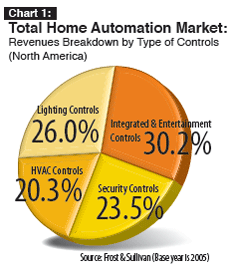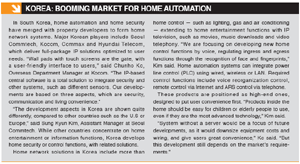Home automation remains one of the fastest growing segments in the building business. Today, more people are scouting for intelligent homes to achieve home security as well as home control. By integrating security and home automation systems, an intelligent home provides a fresh approach to day-to-day events by controlling the whole house with a single button.
Home automation remains one of the fastest growing segments in the building business. Today, more people are scouting for intelligent homes to achieve home security as well as home control. By integrating security and home automation systems, an intelligent home provides a fresh approach to day-to-day events by controlling the whole house with a single button.
The worldwide home automation market is witnessing amplified demand due to the rise of IP-based solutions and increasing security awareness among homeowners. Retrofit technologies and solutions are spurring the integration of security systems and home controls to reflect a more complete vision of home safety and security.
Some home automation providers manufacture integrated systems, with a base in security controls. This packaged offering has helped expand the customer base for security systems. In recent years, the total revenues for the North Ame r i c an home aut oma t i on market were US$1.3 billion, at an annual growth rate of about 8 percent, according to Jorge Moreno, Program Manager for Frost & Sullivan's Environmental and Building Technologies practice.
Another major home automation market, Korea, has grown 36.4 percent (including equipment and services), amounting to more than $2 billion in 2006. The Korea Home Network Industry Association forecast the Korean home network system market to grow about $11.5 billion, while the home network equipment market was expected to grow to $4.1 billion by 2010.
¨The industry has made great leaps to provide open protocols for controls, as opposed to keeping a layer of proprietary closed-end protocols at the user interface,〃 Moreno said. ¨An open system enables interoperability and integration between the different elements of home automation. Meanwhile, wireless systems have been at the forefront of technological innovation and provide less costly solutions for home automation installations.〃
Home theater and audio systems form a significant portion of the home automation market. The entertainment aspecth as proved to be a major avenue for the security providers to enter homes. Many manufacturers provide integration of security systems with entertainment systems, propelling the growth of home automation.
Integration in Smart Homes
An integrated system boosts the security of a home as well as providing convenience. The home automation market has four major segments: security, HVAC (heating, ventilation and air conditioning), entertainment, and lighting. All the sectors are intertwined with each other, each of them important to homeowners. Home automation products are remote controls, motion detectors, magnetic door contacts, thermostats and GSM/LAN dialers communicating directly with a control panel, or with range of receivers and sirens.

¨Offering one platform with multiple functions is a topical subject,〃 said Klara Horackova, Marketing Manager at Jablotron. Different projects might require the same set of security devices. ¨The very same detector not only protects your premises but also arms/disarms the system or informs you when somebody enters your house. With an unlimited number of possibilities, we are developing more products for making the intrusion system to be a really smart house system.〃
Features of an integrated intelligent home include never having to walk into a dark home and lights automatically turning on. In the event of a fire, the air conditioning can shut itself off, all lights inside the house can switch on for a safe exit and exterior lights can flash to alert emergency vehicles.
Residential security solutions are linked with different security systems, such as video surveillance and access control. Once an alarm is triggered, cameras installed in designated surveillance zones can immediately send images to the homeowner or central station. Video feeds can be also displayed live on the home TV or on touch screens. The main control unit can send alerts to security centers or police departments during emergencies, improving security. More intruder alarm systems now allow homeowners to check on their homes in real time and implement more automated functions.

Another trend is energy management. Energy management is taking off in the U.S. because of rising energy prices and increased consumer awareness regarding personal consumption, said Thomas Pickral, Manager of Business Development at HAI.
HAI has a built - in digital communicator, which can dial up to eight phone numbers chosen by the owner for voice notification.
In addition, one GSM dialer from Jablotron can be used to send SMS messages. It can receive command messages and resend unknown SMS messages. It can also be operated remotely from any phone by standard DTMF signals. Each relay can be operated by up to 50 phone numbers, with each number having designated functions.
Distributed Control
¨Distributed control〃 in home automation means the controller (user interface) could be in many places on the home network. ¨The user interface is key to a home automation system,〃 said Eric Micko, Director at Suren Systems. The interface could be a video door phone, wall pad, keypad (graphic or non-graphic) or control panel. In Korea and Japan, people are accustomed to electronic devices, making graphic user interface (GUI) wall pads with multiple options popular.
On the other hand, user in the U.S and Europe do not care for complex interfaces, preferring simpler ones instead. Different countries may require different types of interfaces, yet all manufacturers are committed to providing ultra-simple and compelling user interfaces, Micko said. A robust set of services, and sophisticated design and integration are crucial as well.
For instance, Lagotek offers different types of user interfaces, using touch screens, mobile phones, PDAs or PCs connected to the Internet. As long as they are in the same system, they can update each other to control home and security appliances remotely. Users can make changes to the system, such as switching lighting on and off. The other interfaces will be updated simultaneously about the lighting.
Wired and Wireless Communication
All digital platforms and devices are converging, along with wireless and wired communication platforms. Communication between home automation systems and devices can be accomplished in a variety of ways, including contact closures, serial connections and Ethernet connections.

¨Recently, a new segment has emerged based on the availability of standard computer platforms, either Windows or Linux-based, that use the growing popularity of Ethernet connections to communicate between systems and devices,〃 said Samuel Pai, Director, Strategy and Business Development, ADT Security Services. ¨Life|Ware and Control14 are the latest and most promoted entrants to this segment.Using standardized devices has lowered the price for automation systems, opening up new segments.〃
Wireless communication protocols are popular, such as Wi-Fi, Zigbee and Z-Wave, for integrating wireless alarms with home automation and surveillance systems. They decrease the cost of automation systems by making installations easier. Developing standardized protocols further decrease installation costs to communicate between systems, such as Web Services for Devices (WSD), an extension of Microsoftˇs Web Services architecture. However, WSD is a recent development and has not been fully adopted by the industry. ¨Sometimes, wireless is tough, though, in that there is not one set protocol,〃 Pickral said. ¨As a result, not all wireless products work well with one another.〃
Upcoming Market Trends
¨Many developments of our products are influenced by our customers and distributorsˇ expectations and needs,〃 Horackova said. For instance, specially shaped window detectors can be placed directly into window frames for switching off heating when windows are opened. The product is popular in hotels, as well as in private houses, for saving heating and cooling costs. A security system has motion and contact sensors, which are the eyes and ears of an intelligent home. ¨We do use technology which were used for intruder alarms and widen its usage to integrate all possibilities into one clever system,〃 Horackova said.
¨Performance is upgraded as necessary,〃 Pickral said. ¨We have added additional serial ports that allow for connectivity to other products, such as irrigation and window covering.〃 Moreover, HAI will use Flash memory for all home controllers to be easily updated, without having to install computer chips. Utilizing the USB 2.0 protocol enables lighting control for swifter reaction times, improved communication and enhanced noise immunity.
Enhanced product design is important as the home automation market expands. Not only do customers want the products perform well, they want them look attractive on a wall. Many suppliers in Korea and the U.S are coming out with 10- and 10.2-inch models, as well as portable 8-inch models.
Home automation is a promising industry. IP-based home automation products are spreading quickly worldwide. Some Asian countries request home network solutions, especially the growing Chinese real estate market. China demands home network systems with security and electronic controls. Similar systems are also in demand in the United Arab Emirates and Vietnam.
The challenges and issues for home automation are reliability and interoperability. Interoperability is key, as the goal of an automated home is to link as many things together as possible, making the home more efficient and convenient.